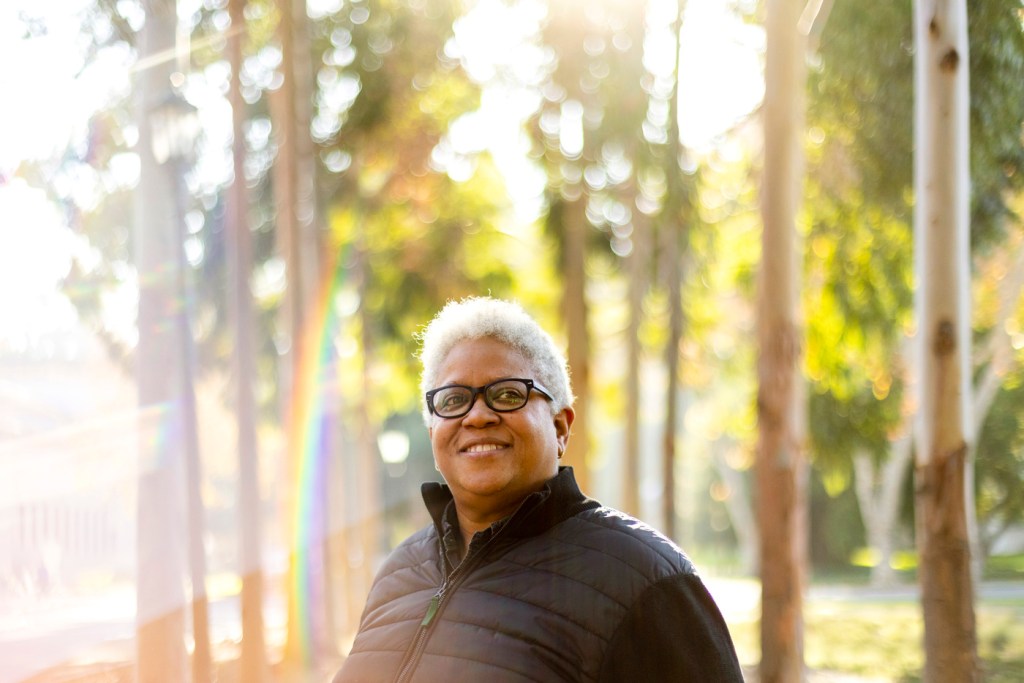‘Living While Black:’ What’s criminal often depends on who’s doing the activity, Northeastern professor says in book

OAKLAND, Calif.—In San Francisco, a white woman calls police on an 8-year-old Black girl selling water without a permit. In Florida, a 54-year-old Black man has his bike confiscated by police when he can’t produce a receipt to prove he owns it. And in Tennessee, a Black teenager is arrested for violating a mall’s “no-hoodie” policy.
Selling water, riding a bike and wearing a hooded sweatshirt are three of the everyday, legal activities Black men, women and children have been arrested, harrassed or killed for doing, according to Ajuan Mance, a professor at Mills College at Northeastern University, whose book, “Living While Black: Portraits of Everyday Resistance,” will be released Oct. 25.
The project began as a series of illustrations inspired by the 2020 Black Lives Matter protests. Concern for the health of loved ones prevented Mance from gathering in crowds, so she sought other ways to express herself.
“I started drawing pictures of Black people very much alive and well,” Mance says. “Brightly colored pictures of Black people doing regular activities.”
The subjects are young and old, laughing and crying, all of them enjoying the simple pleasures of life and all of them Black. She posted 20 of the drawings on Instagram, which sparked a conversation with a book editor.
“Living While Black” denounces the excessive surveillance of Black people, Mance says, and celebrates the courage and resilience of the Black community and its quest for justice, equity and joy. The book’s foreword is written by BLM co-founder Alicia Garza.
“One of the themes of the book is that our notion of what is criminal really depends on who’s doing the activity,” Mance says. “Some things are considered suspicious for some people, but not for others.”
In the book, Mance provides a definition for each activity along with a timeline of injustices committed against African Americans, including the shooting death of Oscar Grant at an Oakland train station on New Year’s Day 2009. She was shocked at the number of incidents involving the elderly and children.
“It was kind of an intense process, looking up all of these incidents,” Mance says. “It was really depressing, so I kept having to step away for a little while, then come back. Even as a professor who teaches African American literature, I didn’t realize the scope, magnitude and severity of some of these incidents.”
Mance hopes the book gives people of all races a sense of reflection, possibility and hope.
“Black people are aware of being seen a bit differently in certain contexts, but it does not stop them from living their lives and finding joy,” she says.
Mance was born in Daytona Beach, Florida, and grew up on Long Island, New York, where she was introduced to the arts. She earned her undergraduate degree from Brown University, her master’s and doctorate from the University of Michigan, and was an English professor at the University of Oregon from 1995 to 1999 before coming to Mills.
Mance built her career as a historian of Black literature, but she’s equally as passionate about the arts. After moving to the Bay Area, she joined several artist groups, including The Art of Living Black, and her “The Ancestors’ Jubilee” series was featured at an exhibition of Black women artists in San Francisco.
“I really felt bolstered,” she says, “I thought, ‘Oh, there is an audience. I can be a part of this community.’ So as much as I worked on my scholarship and teaching, I also made sure to carve out time for art.”
Mance says she mostly depicts Black subjects or scenes from diverse communities.
“My artwork definitely pushes back on some of the narrower representations of blackness that I study and teach my students about,” Mance says. “Some of the same things that inform Black writers, the Black writers who I teach, inform the art that I make.”
“Living While Black” is Mance’s second book of illustrations published this year. “1001 Black Men: Portraits of Masculinity at the Intersections” was released in July. That book began as an online sketchbook in June 2010 when Mance found herself browsing magazines in a grocery store.
One of the magazines celebrated Black men.
“The text was terrific, but I noticed that most of the representations were of very wealthy, very athletic looking Black men,” she says.
That’s when Mance came up with the idea for her “1001 Black Men” project.
“I wanted to see what chronicling Black manhood and masculinity would look like if it was all-inclusive, if someone set out to depict the full range of Black men who they encountered in their life,” she says.
For the next six years, Mance drew portraits of Black men she encountered in her travels. The book is a “snapshot of the African American community,” she says, and includes interviews with Black poets, authors and activists.
A launch party for “1001 Black Men” was held in August at the Cartoon Art Museum in San Francisco. A standing-room only crowd had high praise and lots of questions, including what Mance learned while drawing 1,001 people.
“I learned that I have some strong biases in me and how I look at the world around me,” she says. “And that I gravitate toward people who remind me of my dad and my uncles. So I drew a lot of men in suits, businessmen and elders.”
For media inquiries, please contact media@northeastern.edu.






